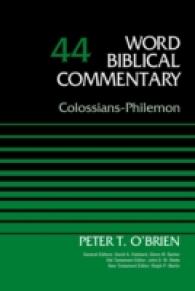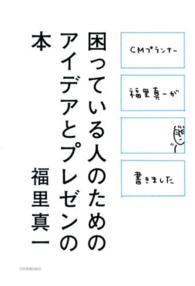- ホーム
- > 洋書
- > 英文書
- > Business / Economics
Full Description
1. 1. Oil price fluctuations and their impact on economic performance Drastic oil price fluctuations have been a major characteristic of the world petroleum market since the beginning of the seventies. The oil crises of 1973n4 and 1979/80 were followed by a dramatic drop of the oil price during the first two quarters of 1986. Starting from a level less than 2 $ per barrel in 1972, the spot market price of Arabian Light crude oil increased to some 35 $ in 1980, then slowly decreased, and finally fell to 13 $ in 1986 (annual averages). If monthly data are considered, the peaks of the oil price movement look even more dramatic. In December 1980 Arabian crude was traded for more than 40 $ a barrel, and in August 1986 the price was down at 8 $ (see Fig. 1. 1). 40 30 20 10 r o 84 88 76 80 72 Figure 1. 1: The spot market price of Saudi-Arabian Light crude oil! ! Data are taken from the Petroleum Economist and the OPEC Bulletin, various issues. 2 After the Second World War petroleum has become the most important energy resource. During the fifties and sixties its price was relatively low compared to other energy 2 sources like coal and firewood and it tended to drive them out of the market.
Contents
1. Introduction.- 1.1. Oil price fluctuations and their impact on economic performance.- 1.2. Plan of the study.- 2. The world petroleum market: history and institutions.- 2.1. Petroleum as an exhaustible resource.- 2.2. The Organization of Petroleum Exporting Countries.- 2.3. The price of petroleum.- 2.4. A brief history of the world petroleum market.- 2.5. Summary of some stylised facts.- 3. The price of petroleum in economic theory.- 3.1. Types of oil market models.- 3.2. The economic theory of exhaustible resources.- 3.3. Parameter changes in the standard model.- 3.4. Approaches without exhaustibility.- 3.5. An evaluation.- 4. An intertemporal model of OPEC's pricing policy.- 4.1. Basic assumptions.- 4.2. Necessary conditions of optimality.- 4.3. The consumption path.- 4.4. Accumulation of foreign assets and the existence of an optimal solution.- 4.5. The price path.- 4.6. The equilibrium in the long run.- 4.7. An evaluation of the model and its results.- 5. A simplified version of the model.- 5.1. The assumptions.- 5.2. Optimality conditions.- 5.3. The optimal pricing policy.- 5.4. Imperfect information and the occurrence of price shocks.- 5.5. Theoretical results and the empirical oil price cycle: a comparison.- 6. An econometric model of the world petroleum market.- 6.1. Objectives of the investigation.- 6.2. OPEC and oil price fluctuations.- 6.3. Empirical results.- 6.4. Optimal pricing policies in the empirical model.- 7. Final remarks.- 7.1. Summary and conclusions.- 7.2. A remark on policy implications.- 7.3. Areas of future research.- Appendix: Optimal control theory.- A.1. The problem.- A.2. Necessary and sufficient conditions.- A.3. Saddle points and the stability of optimal solutions.- References.








